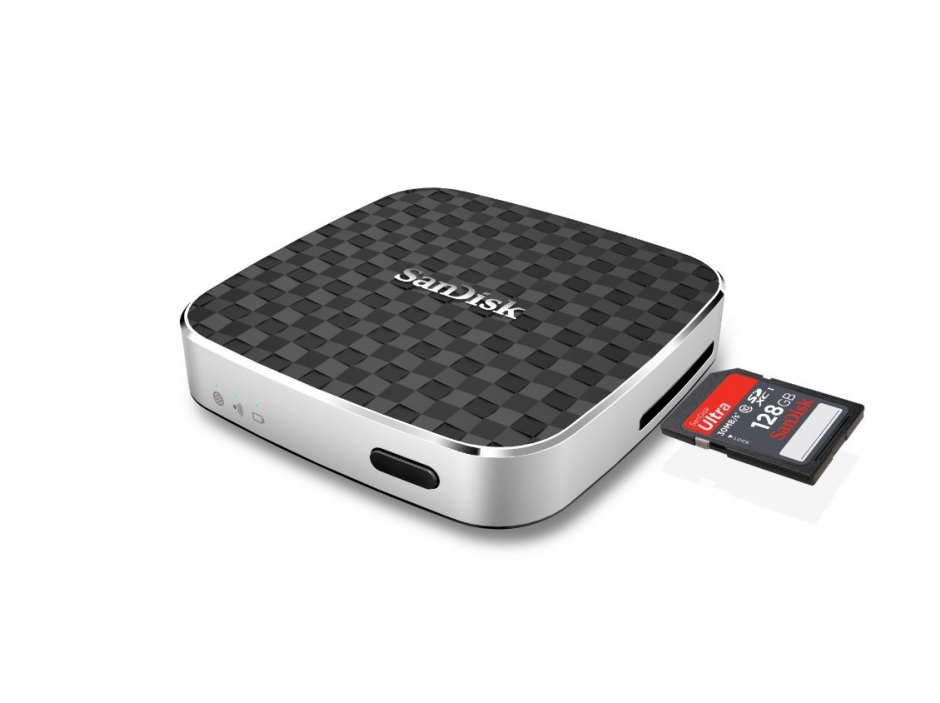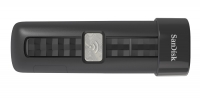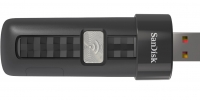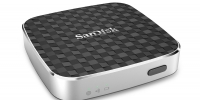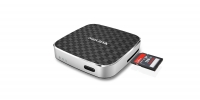What do you do if you run out of room on your iPhone or Android, or just don't want to clutter it up with all the media files you use primarily when you're on a long trip? Sandisk has two solutions that work very well: The Sandisk Connect Wireless Flash Drive and Wireless Media Drive.
The SanDisk Connect Wireless Flash Drive comes with 16 or 32 GB of storage. It looks like a slightly oversized USB thumb drive. You plug it into your computer to send it files (and charge it up) just as you would with a regular drive. The larger unit is about half the size of an iPhone and comes in 32 or 64 bit models.
The magic comes when you press the button on the side of the device. Suddenly it becomes a transmitter wirelessly beaming data to your mobile device.
Now, this is not the only device on the market that has the power to do something like that. In fact, I've previously reviewed the Seagate wireless drives before. Two things, however, make the SanDisk units stand out from the crowd. First, since they use no moving parts they are more rugged and resilient on the road. (Of course, this same "feature" means they have less storage space than a hard drive. So, it is a matter of priorities.) The truly unique, to my knowledge, feature here is that you can still connect to the internet on your mobile device wile streaming a movie from the wireless drive. In the past you had to make a choice between networks, but with the SanDisk drives you can connect to both at once.
As for the specs, they claim a range of 150 feet with a maximum of up to eight simultaneously connected devices.. That may be overgenerous for streaming, but within my apartment I had no problem moving about and maintaining a connection. The units connect with 802.11 b/g and n and are WAP2 protected (safe, but not unbreakable, so treat what you store on them with caution when sitting in a busy airport terminal).
The biggiest differences between the two units (beside the obvious form factor) is battery length and capacity. The smaller unit is rated for four hours and is available in 16 and 32GB models, the larger works up to eight hours, comes in 32 and 64GB sizes, and also sports an SD card reader. It is also a bit heavier and requires a cable to connect. That last detail may not seem too significant, but not too long ago I was running around a small village in India looking for a mini-USB cable because mine had gone missing. The convenience of just being able to plug the SanDisk thumb drive into a machine without a cable makes it very convenient for travel.
I wish the media player that comes with the drives was a bit more robust. It doesn't support playlists, for example. Also, particularly if you have a high-megapixal camera you probably wouldn't want use this as a backup for photos from a big trip. Even the biggest unit only holds two 32GB SD cards. I also think it would be better if they came in different colors; the black is just too easy to lose in the seat cushions.
I put the SanDisk Drives on the buy list: They give you the ability to bring enough movies and music along for a decent journey, even for unlimited enjoyment on transcontinental (if not all transatlantic) flights. They deserve serious consideration and might just give you reason to leave the laptop at home.

